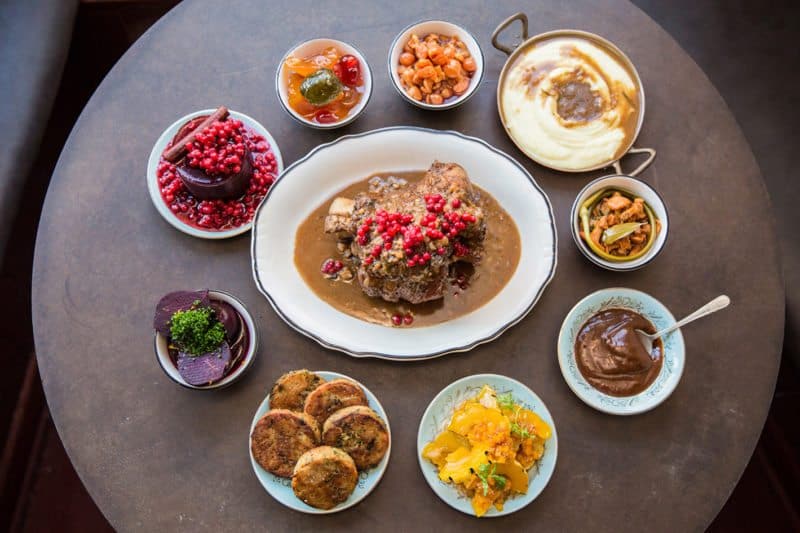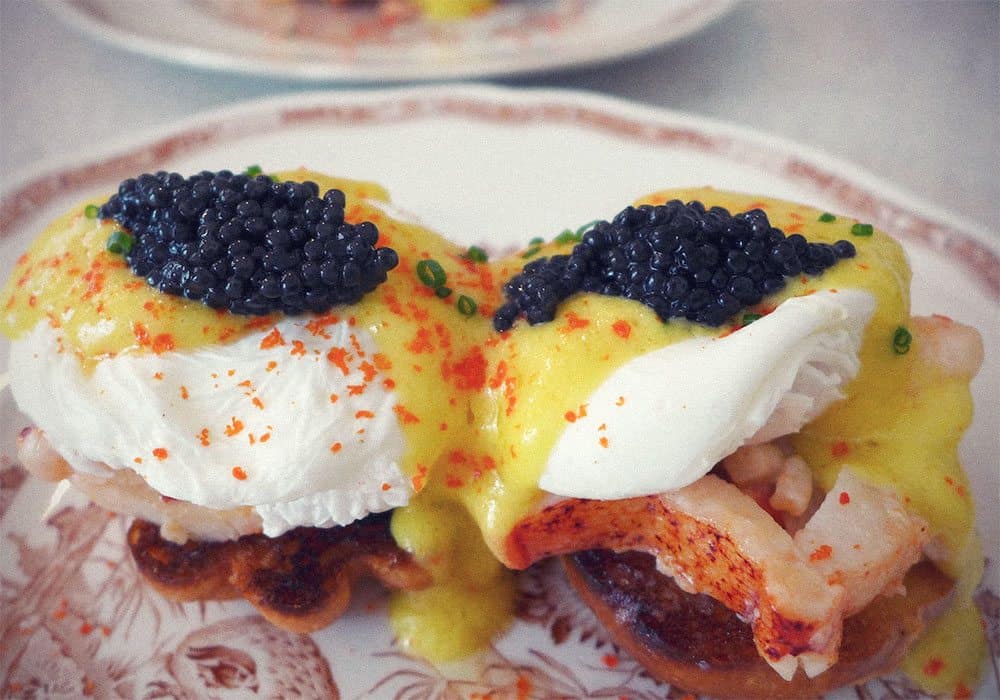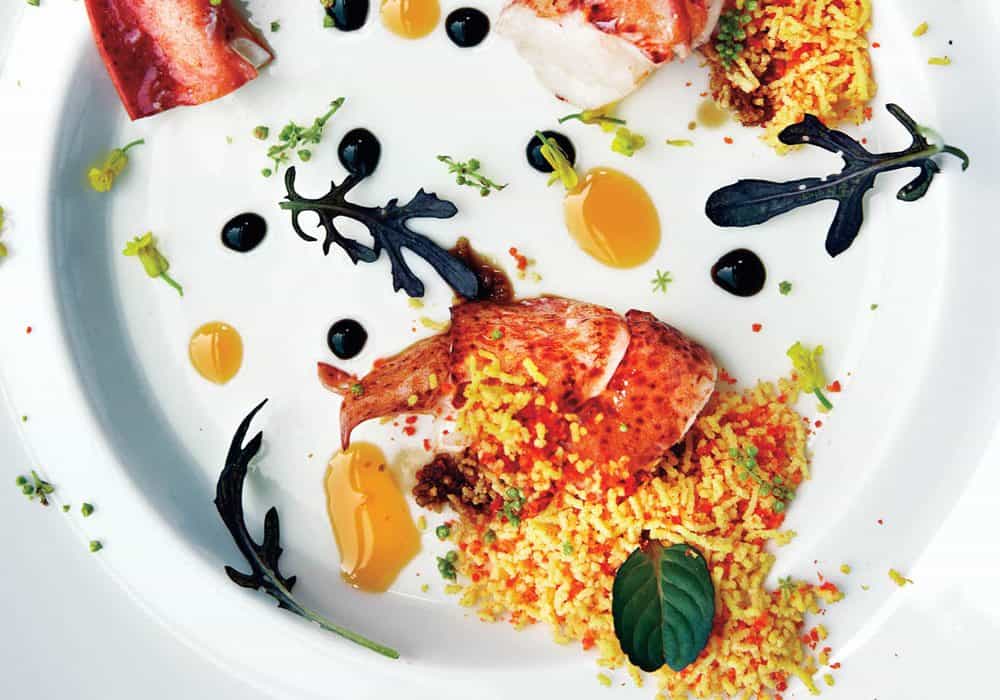
BRAISED VEAL SHANK WITH BREAD-AND-OYSTER DUMPLINGS
By David McMillan
Montreal in the 1800s had a lot of manufacturing and industry
The St. Lawrence Seaway was the highway and a lot of goods were sent to godforsaken places like Prince Edward Island and New Brunswick. There was nothing to bring back so they’d pack barrels with oysters, mud and seaweed for ballast. The original Joe Beef tavern was 35 feet from where the boats were docked. Its customers were boatmen, stevedores and sailors. Oysters were a garbage commodity, but it wasn’t unusual for a businessman to eat 10 dozen oysters with a Porter after work and then go home to his family for dinner.
The tavern served everybody. The rich ate the primary cuts, the middle class ate the secondary cuts, and the poor working class ate the tertiary cuts. This shank dish, Fred Morrin and I learned the recipe over 25 years ago. We were working with chef Nicolas Jongleux at Alain Chapel restaurant in Mionnay, outside Lyon. We glaze it in Porter or wine and I like really basting it so it gets nice and shiny and gorgeous. In Quebec, you’ll find a lot of tertiary cuts on people’s Christmas dinners and a lot of hunted meats. At Joe Beef, we serve a lot more secondary and tertiary cuts just as there are a lot more secondary and tertiary people than primary people. So it makes sense to us that we serve food like that. —D.M
Serves
4
- 60 ml (¼ cup) bacon fat
- 1 tbsp olive oil
- Salt, white pepper
- 1 foreleg shank of milk-fed veal, about 1.4 kg (3 lb)
- 3 onions, minced
- 1 tbsp Dijon mustard
- ¼ tsp ground cinnamon
- 2 cloves, crushed
- 2 juniper berries, crushed
- 1 sprig rosemary
- 500 ml (2 cups) veal stock
- 250 ml (1 cup) red wine or porter (beer)
- ½ veal trotter, sliced about 2 cm (1”) thick
- 60 ml (¼ cup) flour
- 3-4 tbsp butter, soft
- Preserved Quebec lingonberries (or other wild berries) for garnish
Preheat oven to 160°C (325°F).
Melt bacon fat in a heavy-bottomed Dutch oven on medium-high heat. Rub the shank with olive oil, season generously and sear on all sides until golden—about 10 minutes. Remove veal to a platter and lower heat to medium. Add the onions and sauté until lightly caramelized—about 10 minutes. Add mustard, cinnamon, cloves, juniper, rosemary, salt and pepper and cook on medium heat for 2 minutes. Add stock and wine and bring to a boil. Add trotter and return shank (and its juices) to the pot. Cover, and transfer to the oven. Cook, turning shank every 30 minutes or so, until meat is tender and yields easily when pierced with a fork, but is not yet falling off the bone—about 2½ hours. Remove pot to countertop, but do not turn off oven.
Spread four on a baking sheet and transfer to middle rack of the oven. Toast flour until bronzed (like the colour of craft paper)—about 10 minutes. Meanwhile, carefully transfer shank to a warm serving platter, cover with foil or plastic wrap, and keep warm. Use a slotted spoon to remove the sliced trotter and rosemary from the braising liquid. Strip meat from the trotter pieces, shred and return to the pot (discard trotter bones, skin and rosemary). Transfer toasted flour to a bowl, add half the butter and— adding more butter if necessary—work together with the back of a spoon until a smooth paste is formed. Over low heat, whisk the paste into the braising liquid to thicken and enrich it. Taste, and adjust seasonings. Pour sauce over shank and flood the serving platter. Scatter with berries. And enjoy with a good bottle of Northern Rhône syrah (says Joe Beef sommelier sans pareil Vanya Filipovic).
Joe Beef’s Bread and Oyster Dumplings
1 day-old loaf of rye bread, crusts removed, cubed
1 tbsp bacon fat (or butter)
1 medium onion, minced
2 cloves garlic, minced
3 large eggs
350 ml (1½ cups) whipping cream
6 smoked oysters, chopped
1 tbsp Dijon-style prepared mustard
Salt, pepper
3-4 tbsp butter
Preheat oven to 175°C (350°F). Spread half the cubed bread on a baking sheet, transfer to middle rack of the oven and bake until golden (about 30 minutes). Set aside. Meanwhile, in a heavy-bottomed skillet on medium-low, heat the bacon fat and sweat the onions until soft but not coloured – about 7 minutes. Add the garlic and cook for 1 minute longer. Set aside. Combine eggs and a cream in a bowl, and whisk until homogenous. Add the cubed bread (toasted and untoasted), onions, garlic, oysters and mustard. Season well. Mix thoroughly. Taste and adjust seasonings. Arrange a sheet of plastic wrap on a work surface. Spoon the bread mixture onto the plastic wrap. Form it into the shape of cylinder 5-8 cm (2-3”) thick, running lengthwise. Then roll the mixture in plastic wrap, tightly, to form a torchon. Twist the ends and seal. Prick here and there with a fork. Fill a large saucepan with water deep enough to cover the torchon. Bring to a boil and then lower heat to a gentle simmer. Add the torchon and poach until firm – about 6 minutes. Set aside to cool, and then chill. Remove plastic wrap and slice the roll into disks about 1 cm (1/2”) thick. Heat a heavy bottomed non-stick skillet on medium. Working in batches if necessary, add butter, and when it foams, add dumplings. Sear until bronzed and crisp. Flip, repeat, and serve (or keep warm).



